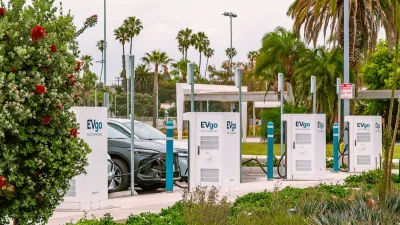With more states outlawing the sales of gas-powered vehicles and the federal government setting ambitious electrification goals, now is the time to invest in critical charging infrastructure.

As policymakers strive to encourage the adoption of electric cars, cities have to contend with finding locations for drivers to charge their vehicles. Henry Grabar reports on the urgent need for more electric car chargers in public parking areas which can serve EV owners living in multi-family buildings who lack access to home charging infrastructure.
According to Grabar,
Many cities are experimenting with EV charging at the curb, and extension cords have been spotted hanging from the windows of East Village tenements and Boston triple-deckers. Street parking has long been a lawless affair, and so far, electric vehicle charging at the curb is working much the same way: every driver for him or herself.
The lack of a concerted effort to bring charging infrastructure to denser neighborhoods, argues Grabar, "raises the possibility that gas-powered cars will continue to dominate in neighborhoods with multifamily housing, and the promise of cleaner air will remain unfulfilled in exactly the places that have suffered the most from the many harms of automobile exhaust."
Grabar goes on to describe the variety of electric vehicle chargers on the market and what he calls the "multidimensional infrastructural problem" that creating a comprehensive charging network poses.
Last month, a group of five Midwestern states joined forces to develop REV Midwest, a network of EV charging stations that will focus on supporting EV adoption in their states, and more states are passing zero-emissions statutes that will prohibit sales of gas-powered vehicles in the next two decades, creating an imminent need for robust charging networks. Meanwhile, the federal infrastructure bill being debated in Congress proposes allocating $7.5 billion to charging infrastructure.
FULL STORY: Where the Heck Are We Going to Charge All of the Electric Cars?

Alabama: Trump Terminates Settlements for Black Communities Harmed By Raw Sewage
Trump deemed the landmark civil rights agreement “illegal DEI and environmental justice policy.”

Planetizen Federal Action Tracker
A weekly monitor of how Trump’s orders and actions are impacting planners and planning in America.

The 120 Year Old Tiny Home Villages That Sheltered San Francisco’s Earthquake Refugees
More than a century ago, San Francisco mobilized to house thousands of residents displaced by the 1906 earthquake. Could their strategy offer a model for the present?

In Both Crashes and Crime, Public Transportation is Far Safer than Driving
Contrary to popular assumptions, public transportation has far lower crash and crime rates than automobile travel. For safer communities, improve and encourage transit travel.

Report: Zoning Reforms Should Complement Nashville’s Ambitious Transit Plan
Without reform, restrictive zoning codes will limit the impact of the city’s planned transit expansion and could exclude some of the residents who depend on transit the most.

Judge Orders Release of Frozen IRA, IIJA Funding
The decision is a victory for environmental groups who charged that freezing funds for critical infrastructure and disaster response programs caused “real and irreparable harm” to communities.
Urban Design for Planners 1: Software Tools
This six-course series explores essential urban design concepts using open source software and equips planners with the tools they need to participate fully in the urban design process.
Planning for Universal Design
Learn the tools for implementing Universal Design in planning regulations.
Clanton & Associates, Inc.
Jessamine County Fiscal Court
Institute for Housing and Urban Development Studies (IHS)
City of Grandview
Harvard GSD Executive Education
Toledo-Lucas County Plan Commissions
Salt Lake City
NYU Wagner Graduate School of Public Service





























